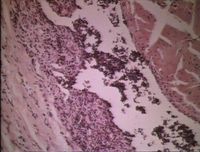Difference between revisions of "Tenosynovitis"
| Line 1: | Line 1: | ||
| + | {{OpenPagesTop}} | ||
==Introduction== | ==Introduction== | ||
[[Image:Synovitis and tenosynovitis.jpg|right|thumb|200px|<small><center>Pig tenosynovitis (Image sourced from Bristol Biomed Image Archive with permission)</center></small>]] | [[Image:Synovitis and tenosynovitis.jpg|right|thumb|200px|<small><center>Pig tenosynovitis (Image sourced from Bristol Biomed Image Archive with permission)</center></small>]] | ||
| Line 69: | Line 70: | ||
{{review}} | {{review}} | ||
| + | |||
| + | {{OpenPages}} | ||
| + | |||
[[Category:Musculoskeletal Diseases - Horse]] | [[Category:Musculoskeletal Diseases - Horse]] | ||
[[Category:Expert Review - Horse]] | [[Category:Expert Review - Horse]] | ||
[[Category:Bursae and Tendons - Pathology]] | [[Category:Bursae and Tendons - Pathology]] | ||
Latest revision as of 18:08, 31 July 2012
Introduction
Tenosynovitis refers to inflammation of the synovial membrane and the fibrous layer of the tendon sheath. It is characterised by distension of the sheath due to synovial effusion and is most commonly seen in horses.
Various types of tenosynovitis occur:
- idiopathic
- acute
- chronic
- septic (infectious)
Idiopathic Tenosynovitis
This refers to the distention of the synovial sheath, usually in young animals, in which the cause is uncertain. It can be seen in the common digital extensor tendon sheath or the extensor carpi radialis tendon sheath. There is usually no identifiable pathology and no lameness and treatment is usually unnecessary.
Acute and Chronic Tenosynovitis
These are due to strain, overuse or trauma and usually seen in older animals. Tendon sheaths most commonly affected include the digital flexor tendon sheath and tendon sheaths associated with the carpus and tarsus. Defects in the Superficial Digital Flexor, Deep Digital Flexor and Suspensory Ligament can cause acute swelling in the sheath and subsequent fibrosis.
Diagnosis
Clinical examination is usually sufficient to establish the presence of tenosynovitis, but the severity and association with lameness require further work-up.
Radiography is usually indicated to evaluate any bony trauma.
Ultrasonography is used to examine the tendons and ligaments in the affected area and identify any injuries, fibrosis, synovial problems or alterations in the synovial fluid.
CT and/or MRI can be used to identify subtle changes in soft tissue and bony structures.
Treatment
Treatment is similar to cases of synovitis and osteoarthritis. This includes: rest, cold hydrotherapy, bandaging, systemic and local NSAIDs.
Systemic hyaluronan can be given to provide lubrication.
Injection of medication into the tendon sheath can be performed in refractory cases, using products such as hyaluronan or corticosteroids.
Tenoscopy may have to be performed to adequately treat any synovial lesions, tears in the deep digital flexor tendon or perform annual ligament desmotomy.
Septic Tenosynovitis
This occurs following trauma and penetration of the digital sheath. It can also follow local extension of infection or haematogenous infection.
Horses are usually markedly lame if the tendon sheath is septic.
Diagnosis
Clinical signs and a wound over the tendon sheath are suggestive.
Radiography, and especially contrast radiography (where contrast is injected into the tendon sheath and any leakage is noted) can be very useful.
Synoviocentesis and microcopic examination for any degenerate neutrophils and intracellular bacteria is very important. The sample should also be submitted for culture and sensitivity tests in order to provide the best antibiotic cover.
Treatment
Septic tenosynovitis requires systemic antibiotics: broad spectrum at first and then according to culture and sensitivity results.
Drainage and lavage of the sheath should also be performed: using several litres of sterile isotonic cystalloid fluids.
NSAIDs can be given to reduce inflammation and pain.
Antibiotics can also be injected into the tendon sheath once it has been flushed.
Open drainage may have to be considered in non-responsive cases.
Prognosis is good provided rapid treatment is given and no adhesions develop between the tendon and the sheath.
| Tenosynovitis Learning Resources | |
|---|---|
 Test your knowledge using flashcard type questions |
Equine Orthopaedics and Rheumatology Q&A 18 |
References
Merck and Co (2008) Merck Veterinary Manual Merial
Baxter, G. (2011) Adams and Stashak's Lameness in Horses John Wiley and Sons
| This article has been peer reviewed but is awaiting expert review. If you would like to help with this, please see more information about expert reviewing. |
Error in widget FBRecommend: unable to write file /var/www/wikivet.net/extensions/Widgets/compiled_templates/wrt6622ca7d0e1506_72542859 Error in widget google+: unable to write file /var/www/wikivet.net/extensions/Widgets/compiled_templates/wrt6622ca7d11a4b8_73679082 Error in widget TwitterTweet: unable to write file /var/www/wikivet.net/extensions/Widgets/compiled_templates/wrt6622ca7d164b29_83476540
|
| WikiVet® Introduction - Help WikiVet - Report a Problem |
